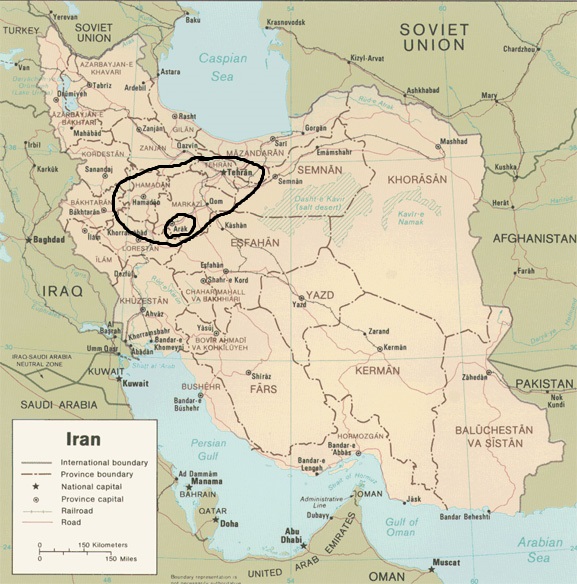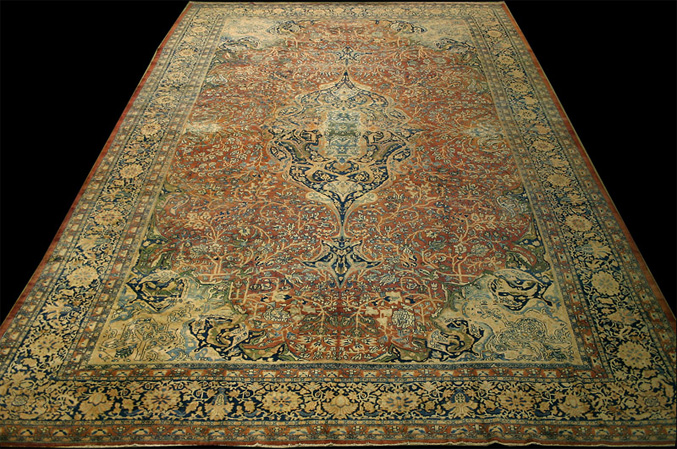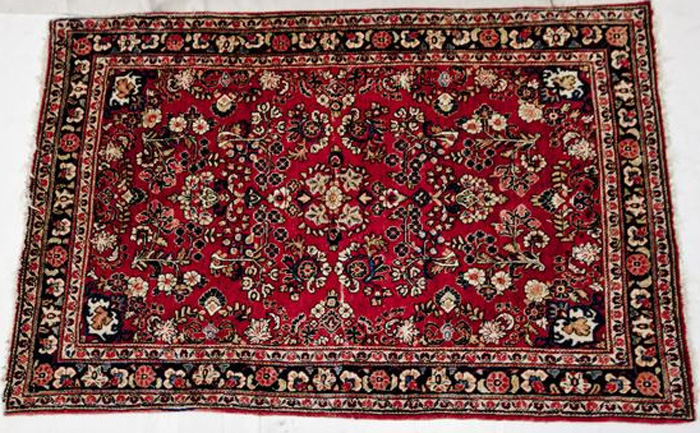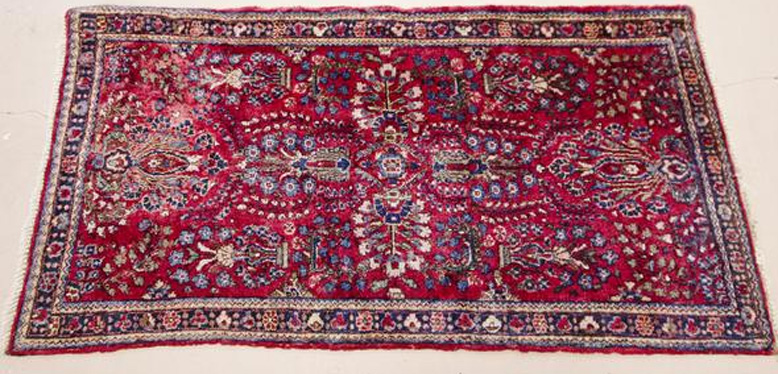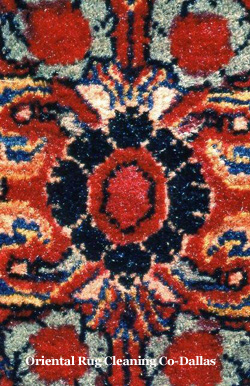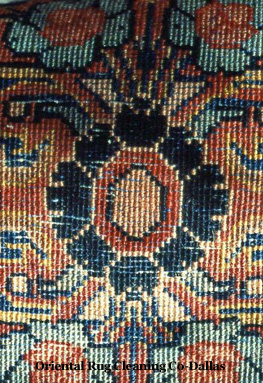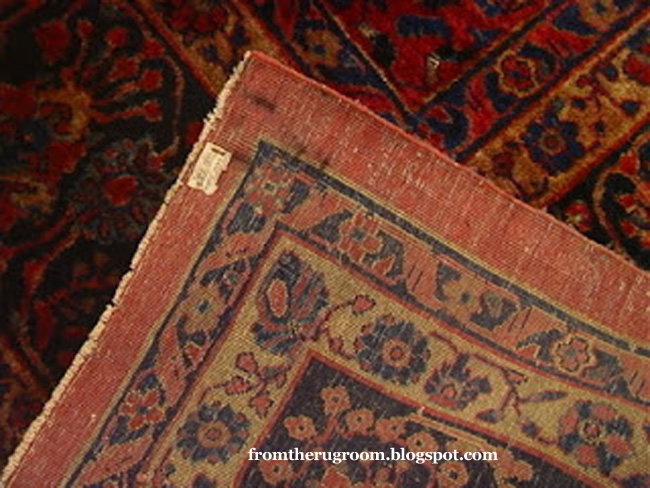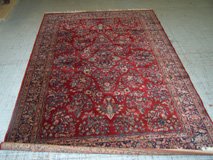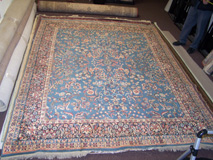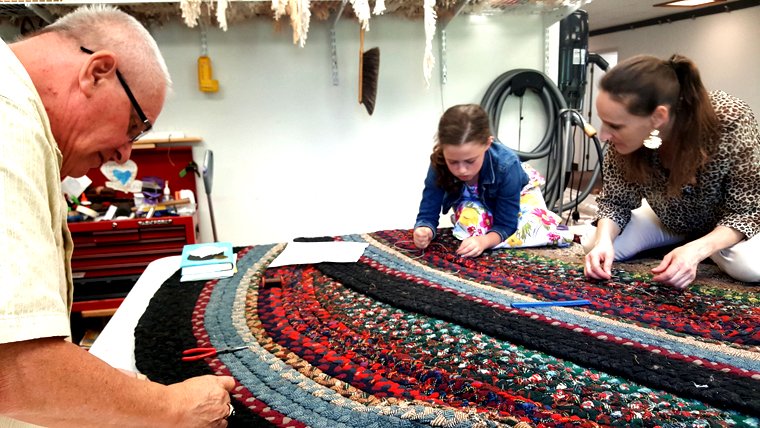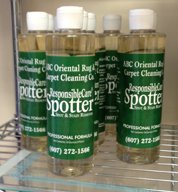SAROUK ORIENTAL RUG DESIGN
The Sarouk oriental rug design, as seen in rugs typically available today, consists of some easily recognizable motifs. The same caveats that apply to all oriental rugs must be repeated:
- The way to accurately identify a handwoven oriental rug is not just from the design, but from the way it is woven and the materials used.
- Many countries produce rugs with designs that may copy another country’s rug.
Because of the individual nature of hand-woven rugs, we can study the most common examples (and there will be variations!) but we must be aware there are many exceptions to every example and the terms ’always’ and ‘never’ do not apply.
SAROUK ORIENTAL RUG DESIGN HISTORY
Traditional Sarouk oriental rug design (Saruq, Sarough) in rugs woven from the late 19th and early to mid-20th century were, for the most part, produced in the region of what is now the Markazi province of Iran and within the area surrounding the city of Arak in northwestern Iran between Tehran and Hamadan.
The Persian rug-making industry had declined to near distinction in the 18th and most of the 19th centuries. Fortunately, thanks to carpet exhibitions held in Vienna and London in the last quarter of the 19th century, a rising demand from the West for these rugs encouraged carpet merchants to organize rug weaving centers in and around Arak.
It did not take long for Western companies to establish themselves in Arak, producing rugs for Western tastes. One of the first of these was Ziegler and Company, established in Tabriz. Other companies spread out in the area and included the Eastern Rug Trading Company of New York and the Atiyeh brothers of Oregon, among others.
FARAHAN SAROUK ORIENTAL RUG DESIGN - ONE OF THE EARLIEST
The Farahan Sarouks were some of the first Sarouk oriental rug designs woven from about approximately 1890 to WWI in town workshops close to the cities.
The Farahan Sarouk designs are typically curvilinear (mostly floral motifs and patterns that are usually more intricate and finer). Their designs were most often medallions on blue or ivory fields with natural dyes. They could also feature trees and birds in pictorial designs.
There were many weaving centers in and around Arak and rugs produced there such as the Lilihan, Mir, Malayer, etc., were often similar in design to the Sarouks, though not necessarily in structure, and were often mistaken for Sarouks.
THE 'AMERICAN' SAROUK ORIENTAL DESIGN
Sarouk rugs produced between the 2 World Wars (approximately 1920s to 1930s) featured naturally dyed
rose-colored fields with blue borders and scattered floral sprays without a center medallion or corners. (A small number of these rugs had blue fields with red borders.) During this time period, Persian Sarouk rugs were made specifically for the American market and were known as 'American Sarouks.'
Americans were not impressed with the original color of the field in the Sarouks produced for them, and as a result, these rugs were taken to Rug Renovating (a firm still operating today in New York City, the port of entry) and chemically stripped and hand re-dyed a deep burgundy to please American tastes. Thousands upon thousands of these rugs were repainted through the 1950s. Other colors were also often altered including greens, blues, yellows, etc.
These stripped and re-dyed Sarouk rugs were known as 'American Sarouks' which distinguishes them from other Sarouks that were produced during that era. Because of the stripping and dying process used in the American Sarouks, some of the colors may have become mottled and uneven over time.
CONSTRUCTION OF THE AMERICAN SAROUK
FOUNDATION
The American Sarouk is a double-wefted rug meaning it is woven with two side to side or weft cords (which are cotton and usually dyed blue).
The top to bottom cords (warps) are also cotton and are depressed. Depressed warps occur when the wefts (side to side cords) are pulled tightly from either side rather than put in with minimal tension. This will displace the warps into 2 levels.
THE KNOT and THE PILE
The knot is the Asymmetrical or Persian knot. The yarn is placed in a loop around one of the warps (up and down foundation cords) and remains loose under the other. The 2 ends emerge on either side of the warp.
The pile is wool.
ENDS and SIDES
The ends can have a plain cotton kilim (a flat area of varying size woven at the end of the rug before the fringe is finished) at one end with knotted fringe on the other end while others have plain knotted fringe on both ends.
The sides consist of a single cord overcast in wool.
SAROUK ORIENTAL RUG DESIGN SINCE 1950
The Sarouk oriental rug design has remained the same, whether painted or not. After WWII, the field color was more typically red, rather than burgundy.
The painted 'American Sarouk' rugs can be easily identified by comparing the field color on the back and the front. If the carpet is a light rose on the back and a dark rose or close color on the front, it is probably a painted American Sarouk. (Other rugs in the area, such as the Lilihan, Mahal, Kashan, and Hamadan were also painted.)
The typical Sarouk rug that can be found in the market and in rug cleaning plants today can be recognized by its distinctive pattern of floral sprays and bouquets. The most distinguishing characteristic is the use of blue weft threads (foundation threads woven side to side) and red colors mixed with ivories and blues in the design.
The Sarouk oriental design is still one of the most popular Persian rug designs and has been copied by other countries such as India, China, and Romania.
QUESTIONS ABOUT SAROUK ORIENTAL RUGS?
Please feel free to call or text our office at 607-272-1566 if you have any questions about Sarouk oriental rugs or about any other rugs. Our staff is trained in oriental rug ID, cleaning, and repair.
We have a full-service repair department for oriental and other area rugs, and we would be happy to advise you. All work is done on our premises by trained technicians.
Our office is open from 8 to 5 Monday through Thursday, closing at 4:30 on Fridays. We are also open from 10 to 1 on Saturdays.
Top of Sarouk Oriental Rug Design
"The Cleanest Clean You've Ever Seen."
by
ABC Oriental Rug & Carpet Cleaning Co.
130 Cecil Malone Drive Ithaca, NY 14850
607-272-1566
GIVE THE
GIFT OF CLEAN!

Why not think 'outside the box' and give
a Gift Certificate for professional carpet, upholstery, or tile
& grout cleaning from ABC for any special occasion!
Does a special person have a favorite area rug or oriental rug that needs cleaning or repair? Just give us a call. You'll make their day!
Bring in the mats from a car and we'll clean them as well.
Contact
us if you live in the Ithaca, NY or surrounding areas and we will
tailor a special gift certificate just for you for any Special Occasion.
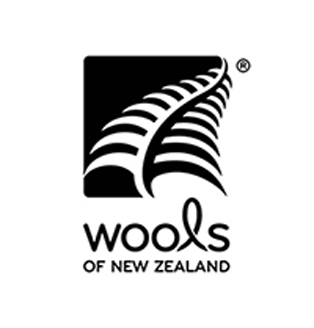
The Standard of Excellence
ABC
Carpet & Rug
Spotting Guide
Learn how to remove spots with ordinary household solutions
Sign up below to gain access to your complementary Spotting Guide from ABC.
Registering your email address guarantees you will be notified whenever discount savings coupons become available.
Did you know that our ABC Responsible Care Spotter can get those pesky spots out of your carpet and rugs and will work equally as well on your clothes and upholstery?
Stop by our office and pick one up. They are $5.00 + Tax but if you have carpets or upholstery cleaned in your home or business, just request a free one from your Technician.
And don't forget to fill out the form above to download your free ABC Spotting Guide!
